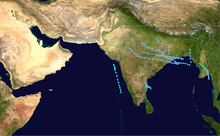Late 19th century
1864 Calcutta cyclone
|
Main article: 1864 Calcutta cyclone |

On 5 October a powerful cyclone hit near Calcutta, India, killing around 300,100 people.[17] The anemometer in the city was blown away during the cyclone. Over 100 brick homes and tens of thousands of tiled and straw huts were leveled. Most ships in the harbor (172 out of 195) were either damaged or destroyed.[18] The cyclone of 1864 destroyed the ports at Khejuri and Hijli.[19]
November 1867 Great Calcutta cyclone
The anemometer in the city was blown away during the cyclone. A lack of storm surge minimized the overall damage from this system.[18]
October 1874 Bengal cyclone
This severe cyclone killed 80,000 people and caused significant damage.[15]
October 1876 Backerganj cyclone
|
Main article: 1876 Bengal cyclone |
On 31 October a cyclone hit the Meghna River Delta area of India. The storm surge killed 100,000, and the disease after the storm killed another 100,000.[citation needed]
1877 season

1878 season

1879 season

1880 season

June 1885 Aden cyclone
A cyclone had formed near the Laccadive Islands on 24 May 555 kilometres (345 mi) west of southern India. The SS Mergui encountered the cyclone off the Horn of Africa, 400 kilometres (250 mi) east of Socotra on 1 June and reported it stronger than the tropical cyclone which struck Calcutta in 1864. Just before midnight on the night of 1 June the Diomed reported winds of hurricane force and a pressure of 984 millibars (29.1 inHg). The ship Peshawar reported a westerly hurricane at the east end of the Gulf of Aden towards midnight on the night of 2 June. At noon on 3 June the Tantallon reported a pressure of 943 millibars (27.8 inHg) near 12.5N 45.5E. On 3 June the German corvette Augusta, the French dispatch boat Renard, and the British ship SS Speke Hall were lost in the storm in the Gulf of Aden. The system continued westward and shrank in as it moved into the entrance of the Red Sea, crossing the coast of Djibouti. It became the first north Indian ocean tropical cyclone in history to transit the Gulf of Aden with full hurricane intensity and held the record of westernmost landfalling North Indian Ocean tropical cyclone ever.[20]
1885 Odisha cyclone
An intense cyclone struck Odisha.[13] It killed one person.
1888 Gujarat cyclone
In November a violent cyclonic storm with hurricane-force winds struck Gujarat causing a ship sunk, killing 1300 people.[citation needed]